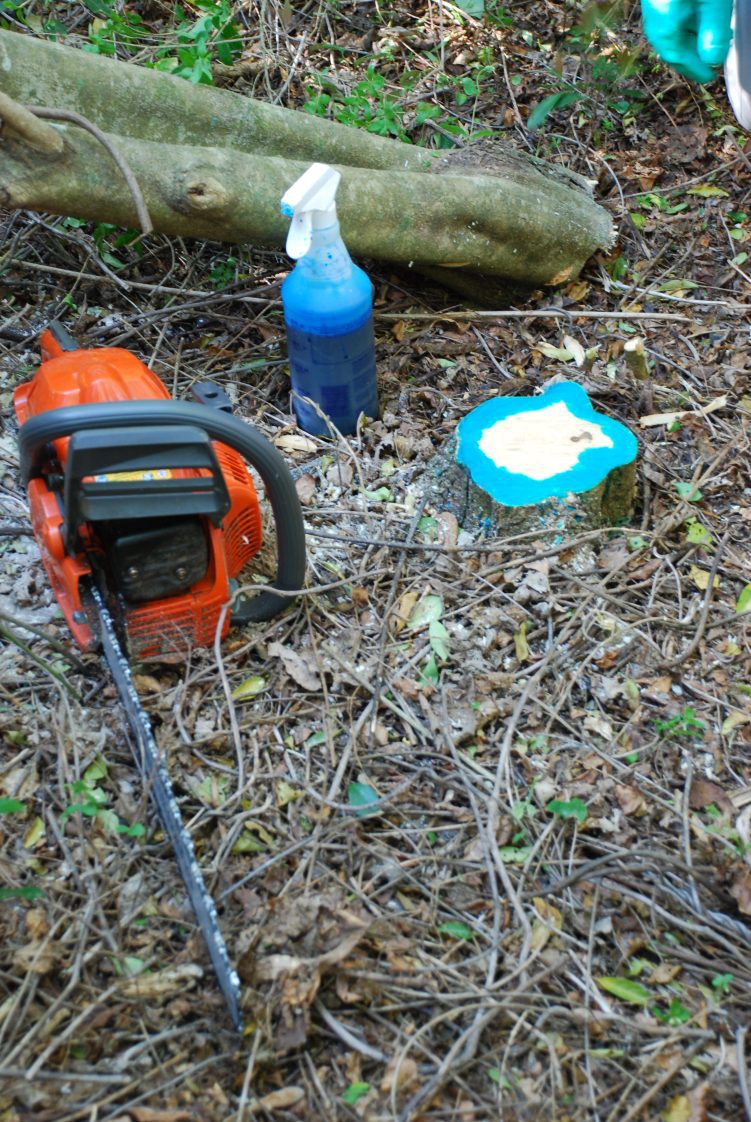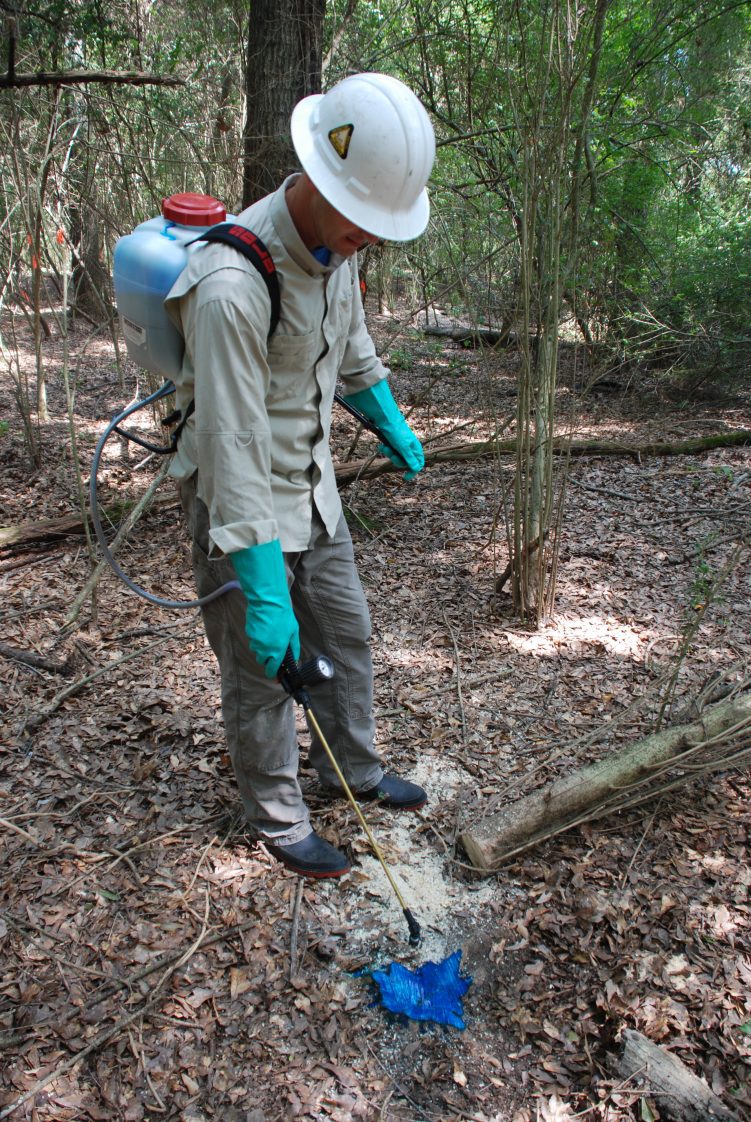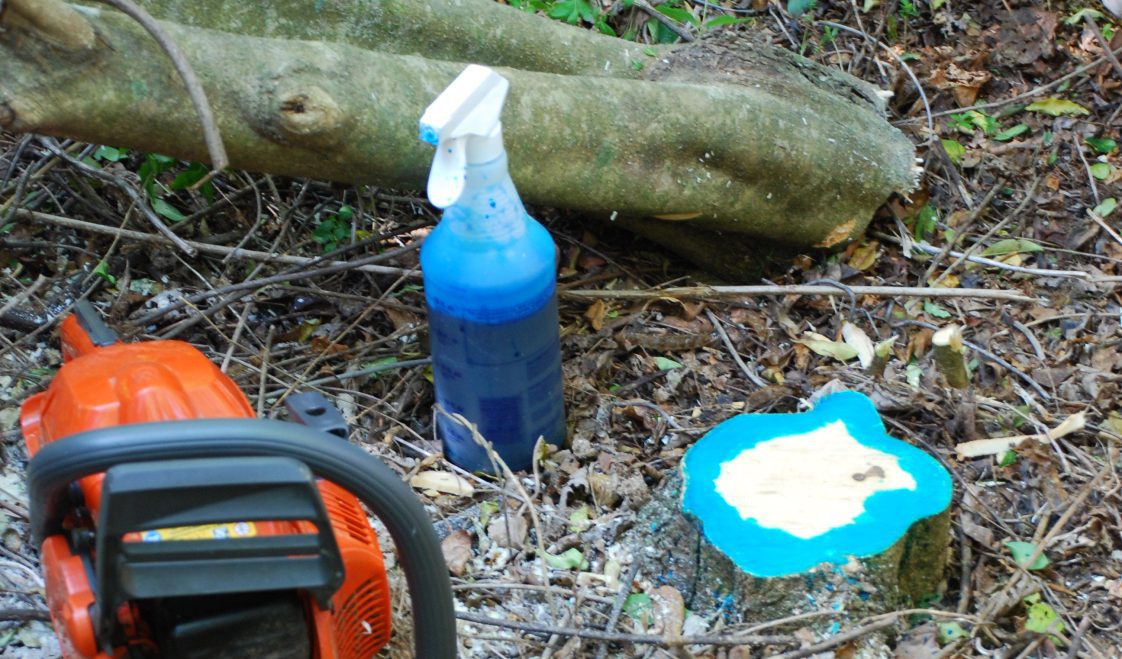Forestry

Learn the correct procedure for controlling woody plants with the cut stump treatment method—a simple way to control woody plants. An herbicide solution is applied directly to the stump top immediately after cutting down the plant.
What is a cut stump herbicide treatment?
Cut stump herbicide treatment is a simple way to control woody invasive plants. An herbicide solution is applied directly to the stump top immediately after cutting down the plant. The herbicide kills the stump and prevents new growth that would normally occur after cutting alone.

Figure 1. Cut stump treatments are an effective method for woody plant control, including many invasive species.
Is a cut stump herbicide treatment the best option for my situation?
Cut stump treatments are most useful where the target tree or shrub density is relatively low, manual labor is available, and dead standing trees and shrubs are not desired. This method can be used selectively with no damage to surrounding vegetation. Cut stump treatment is not recommended where thousands of stems per acre need to be treated or where trees or shrubs cannot be safely felled and piled if needed.
For what size woody plants will this method work?
The cut stump treatment method is effective on almost any size woody invasive plant, including large woody vines. However, small stems less than a half-inch in diameter are not consistently controlled.
What is the best time of year to use this method?
Cut stump treatments with most woody plants can be done almost any time of the year. While late summer through fall is often the optimal time, late fall may be the easiest time from an operational standpoint. Temperatures are cooler, herbaceous vegetation is dormant, and undesirable critters are less active. The only time cut stump treatments should not be done is in the early spring when trees are experiencing strong upward sap flow. This is evident when stumps appear to “bleed” water following cutting.
What equipment do I need?
You typically need a good chainsaw for larger stems, although a lightweight brush saw is fine for smaller stems. A handsaw or pruning shears are adequate for smaller stems as well. Cut stump herbicide treatments are most easily applied with backpack sprayers or handheld pressurized spray bottles, but they can also be applied with a paintbrush.
What stump height should I cut?
The best option is to cut close to the ground, leaving a 1- to 2-inch stump. This avoids leaving taller “ankle breaker” stumps that may be hazardous to walk or drive through.
How soon after cutting do I need to apply the herbicide?
It is best to treat immediately after cutting, within a few minutes at most. Delays in herbicide application may reduce effectiveness.
What herbicide should I use in residential areas?
Herbicides with soil activity can affect nearby nontarget plants through root uptake and are not recommended for residential use. Herbicide products containing active ingredients glyphosate and triclopyr amine have little to no soil activity and are appropriate and effective for residential use. Products may vary in the concentration of these active ingredients, so look closely at the label.
Ready-to-use glyphosate products with less than 20 percent active ingredient will not consistently work for cut stump treatment. Glyphosate products with 20 percent active ingredient can be effectively used for some species but should not be diluted.
The most cost-effective option for larger projects is to use a glyphosate product with 41 percent or higher active ingredient. This will need to be diluted before use. Mix an equal amount of herbicide with water to make a 50 percent solution. This is often expressed as a 50 percent v/v or vol/vol solution.
Ready-to-use triclopyr amine products with less than 8 percent active ingredient will not consistently work for cut stump treatment. Triclopyr products with 8 percent active ingredient can be effectively used but should not be diluted.
A small amount goes a long way when treating stumps. Start with a pint or quart of herbicide product or solution. Adding a spray indicator, such as a colorant or dye, may be useful to see what has been treated.
When using herbicides, always read and follow the label.
What herbicides can be used for nonresidential use?
Glyphosate and triclopyr amine also work well in many nonresidential situations, but there are additional choices to consider (table 1). Options will vary by species and site. Refer to the herbicide label for specific species and site recommendations. In particular, if treating stumps near water, use products with labels that specify allowing aquatic applications.
How do I apply?
The easiest approach is carefully spraying or painting the stump top with the herbicide after cutting. The most critical area of the stump top to cover is just inside the bark, or approximately 2 inches around the entire circumference. This is where the herbicide is most effectively transferred to the roots. For stems less than about 4 inches in diameter, it is often easier to treat the entire stump top. For plants with multiple stems, be sure to treat each stump. If using a pressurized sprayer, maintain a very low pressure to avoid puddling and waste.
If the herbicide treatment must be delayed following cutting, the entire surface and sides of the stump should be sprayed. Use a triclopyr ester herbicide product mixed with oil instead of water (see table 1). Treatment should take place within a few weeks of cutting.
Table 1. Recommended Herbicide Rates and Uses for Nonresidential Sites
b For some species, such as Chinese privet (Ligustrum sinense), 25% v/v provides good control.
c Herbicide is mixed with a penetrating oil carrier rather than water to allow it to penetrate through the bark. Diesel fuel can be used, but newer oil carriers such as basal and bark oils are safer and just as effective. Spray sides of stump as well as the top of the cut stump.
| Herbicide Active Ingredient | Herbicide Trade Name | Rate | Site |
|---|---|---|---|
| Aminocyclopyrachlor a | Method | 5 to 10% v/v | Noncrop sites (rights-of-way, fence rows, industrial areas, substations, etc.) |
| Glyphosate | Roundup or generics (41% active ingredient or higher) | 50 to 100% v/v b | Industrial sites, forestry, range and pasture, rights-of-way |
| Imazapyr a | Arsenal (2 lb ae), Habitat, or generics | 6 to 9% v/v | Noncrop, range and pasture, aquatic, forestry, natural areas |
| Triclopyr amine | Garlon 3A, Renovate or generics | 50 to 100% v/v | Forests, noncrop areas, natural areas, range and pasture |
| Triclopyr ester | Garlon 4 Ultra, Remedy Ultra, Relegate, Pathfinder II, or generics | 20 to 30% v/v sol + penetrating oil c | Forests, noncrop areas, natural areas, range and pasture |
| Triclopyr acid | Trycera | 50 to 100% v/v | Noncrop, range and pasture, aquatic, forestry, natural areas |

Figure 2. Safety glasses and herbicide-resistant gloves are a must for cut stump treatments. A hard hat is recommended when cutting large shrubs or trees.
Will rain just after treatment reduce effectiveness?
Yes. Cut stump treatments should not be done when rain is expected within 4 to 6 hours.
What safety gear should I use when doing cut stump herbicide treatments?
Safety precautions must be taken for both cutting and herbicide treatment (figure 2). Always follow the herbicide label and use the required personal protective equipment. Avoid leather gloves and leather boots when applying herbicides as they readily adsorb many herbicides. Use eye protection at all times when doing cut stump treatments.
 Revised by Nancy Loewenstein, Extension Specialist, Forestry, Wildlife, and Natural Resource Management, and David Russell, Assistant Research and Extension Professor, Auburn University. Originally written by Stephen Enloe, former Extension Specialist; Nancy Loewenstein, Extension Specialist, Forestry, Wildlife, and Natural Resource Management; and Danny Cain, County Extension Coordinator, all with Auburn University.
Revised by Nancy Loewenstein, Extension Specialist, Forestry, Wildlife, and Natural Resource Management, and David Russell, Assistant Research and Extension Professor, Auburn University. Originally written by Stephen Enloe, former Extension Specialist; Nancy Loewenstein, Extension Specialist, Forestry, Wildlife, and Natural Resource Management; and Danny Cain, County Extension Coordinator, all with Auburn University.
Revised August 2023, Cut Stump Herbicide Treatments for Woody Plant Control, ANR-1465

